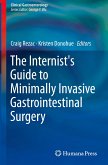Few clinical disciplines have been transformed so dramatically by advancements in science and technology as gastrointestinal surgery. To begin with, modern ph- macology has virtually eliminated some kinds of surgery altogether. If one were to take a peek at a typical operating room schedule in a busy hospital of the 1960s, gastrectomies of one kind or another would have constituted a large block of the major surgeries. The advent of effective H2-histamine receptor antagonists and, more + + recently, the H ,K -ATPase (proton pump) inhibitors led to a precipitous decline in those procedures such that they are rarely performed today. Exciting new approaches to treating inflammatory bowel diseases and their complications-such as fistulas- with anticytokine therapy may one day have a similarly profound effect on surgery for this condition as well. Beyond pharmaceutics, advances in imaging techniques have greatly facilitated the identification and characterization of pathology in the gastrointestinal tract in a way that would have been unimaginable only a few years ago. Just to visualize the pancreas in some way was a horrendous task until abdominal ultrasound, magnetic resonance imaging, or computer tomography made it simple. The fact that the gut is a hollow organ that can be accessed through the mouth, anus, or even through the wall of the abdomen has been fully exploited with fiberoptic endoscopes that can bend around corners with ease and permit surgery to be conducted through them.
Hinweis: Dieser Artikel kann nur an eine deutsche Lieferadresse ausgeliefert werden.
Hinweis: Dieser Artikel kann nur an eine deutsche Lieferadresse ausgeliefert werden.
Foreword by Dr. Tadataka Yamada
"This book is written for internists, gastroenterologists, and other physicians who care for patients with complex GI disease and who interact particularly with surgeons...Each chapter gives a broad overview of a particular disease and then leads into methods of treatment. Where surgery is the primary treatment, the preoperative evaluation and management of patients is discussed. A section on the typical surgical procedures required to treat a disease is then presented. This includes options that are surgical and nonsurgical in nature. The latter part of each chapter includes discussion about survival, postoperative complications, cost, functional outcomes and related topics, and processes. At the end of each chapter is a list of references that are typically classical surgical references. "-Doody's Health Sciences Book Review Journal
"This is a unique textbook directed primarily at practicing internists, but which is equally appropriate for gastroenterologists and trainees in medicine who wish to understand better what would happen to their patients when a surgical choice is made." - Digestive and Liver Disease
"...an excellent guide for medical residents and gastroenterology fellows...a practical and succinct review of GI surgery." - Practical Gastroenterology
"The editors of this book have made a great effort to produce a complete guide not only to gastrointestinal surgery but also to abdominal general surgery, including surgery of the aorta and its branches, and abdominal wall hernia surgery. This book can be thoroughly recommended both for young surgeons and non-visceral surgical residents in surgical departments, and for busy, but interested, general surgical practitioners and physicians." - British Journal of Surgery
"This text, whose contributing authors include professors and chiefs of surgery, surgical subspecialists, medical gastrointestinal subspecialists, chief surgical residents, and medical fellows, is an excellent primer for the primary care physician, medical student, or resident. In a clear, concise, well-organized fashion, the reader is able to develop an appreciation of the standard as well as newer technologic advances in surgery for the management and follow-up of patients with gastrointestinal disease." -Current Surgery
"The unique book is written for primary care providers, family practitioners, gastroenterologists, and others who care for patients who have experienced gastrointestinal surgery. An Internist's IllustratedGuide to Gastrointestinal Surgery speaks well to its intended audience and is recommended for hospital and academic health science libraries." -E-STREAMS
"This book is written for internists, gastroenterologists, and other physicians who care for patients with complex GI disease and who interact particularly with surgeons...Each chapter gives a broad overview of a particular disease and then leads into methods of treatment. Where surgery is the primary treatment, the preoperative evaluation and management of patients is discussed. A section on the typical surgical procedures required to treat a disease is then presented. This includes options that are surgical and nonsurgical in nature. The latter part of each chapter includes discussion about survival, postoperative complications, cost, functional outcomes and related topics, and processes. At the end of each chapter is a list of references that are typically classical surgical references. "-Doody's Health Sciences Book Review Journal
"This is a unique textbook directed primarily at practicing internists, but which is equally appropriate for gastroenterologists and trainees in medicine who wish to understand better what would happen to their patients when a surgical choice is made." - Digestive and Liver Disease
"...an excellent guide for medical residents and gastroenterology fellows...a practical and succinct review of GI surgery." - Practical Gastroenterology
"The editors of this book have made a great effort to produce a complete guide not only to gastrointestinal surgery but also to abdominal general surgery, including surgery of the aorta and its branches, and abdominal wall hernia surgery. This book can be thoroughly recommended both for young surgeons and non-visceral surgical residents in surgical departments, and for busy, but interested, general surgical practitioners and physicians." - British Journal of Surgery
"This text, whose contributing authors include professors and chiefs of surgery, surgical subspecialists, medical gastrointestinal subspecialists, chief surgical residents, and medical fellows, is an excellent primer for the primary care physician, medical student, or resident. In a clear, concise, well-organized fashion, the reader is able to develop an appreciation of the standard as well as newer technologic advances in surgery for the management and follow-up of patients with gastrointestinal disease." -Current Surgery
"The unique book is written for primary care providers, family practitioners, gastroenterologists, and others who care for patients who have experienced gastrointestinal surgery. An Internist's IllustratedGuide to Gastrointestinal Surgery speaks well to its intended audience and is recommended for hospital and academic health science libraries." -E-STREAMS








